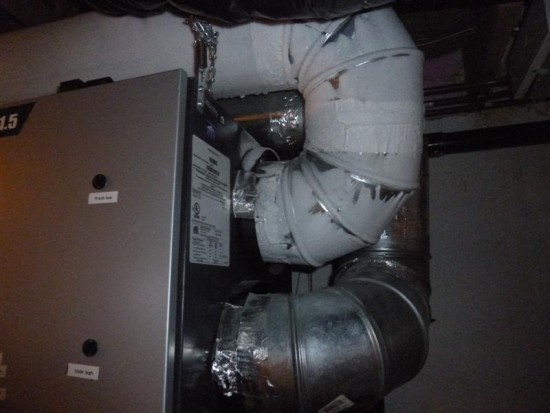In this post Dave Baerg asks “How many malfunctioning HRV defrost systems are out there?”
I met Dave in the summer of 1999 when we worked together at the Urban Environment Centre. Dave took me under his wing and got me interested in building science. Always passionate about his work, Dave explained things well and said “the best place to start air sealing a house is in the attic.” And though he moved to New Liskeard shortly afterwards, those words kept me interested solving condensation and ice-damning problems in some of the worst attics Toronto had to offer.
Ever the teacher, Dave sent me an email recently where he mused about how many HRV cores in northerly climes had their cores frozen with the recent drop in temperature coinciding with the recent Polar Vortex.
Let this be a lesson to those of you with HRVs; if you feel really cold air coming in through your ventilation supply registers, it might be a good idea to open up HRV and have a look under the hood!

HVAC and building envelope consultant Dave Baerg of New Liskeard explains how to identify a frozen core on an HRV. Note the white frost on the “tempered” fresh supply air coming out of the HRV. That’s a lot of cold air being distributed throughout the house!
Dave said about the above picture “As you’ll see, the fresh air duct is covered with frost. I first noticed a problem last winter. When it was -30C or colder, I would come downstairs in the morning and it would be about 18C on the main floor. At first I thought the radiant floor wasn’t able to put out enough heat to meet the main floor heat load. Then I noticed how cold the fresh air was. So, I put a thermometer into a supply register and got a reading in the low minus teens. Then I checked the HRV. The core was frozen solid. So, there was no exhaust flow to warm up the incoming supply. In short, the defrost mechanism wasn’t working. At -28C, it worked, at -30C we had trouble. I finally got my installer out this week to change the sensor. So far so good – we had a low of -31C the other night and it didn’t freeze up.”
Dave went on to say “What disturbs me about this is that I found it because I’m pretty aware of how my house works and, most importantly, my system is direct ducted; so, the supply air was very noticeably cold. Would the average homeowner with forced air – where the fresh air supply is mixed with return air at about a 1:10 ratio – have noticed the problem? How many malfunctioning defrost systems are out there?
So if you own an HRV and the temperature dips, it might be a good time to just have a peak inside or put your hand on the fresh air supply duct to confirm the temperature is significantly higher than outside air!
